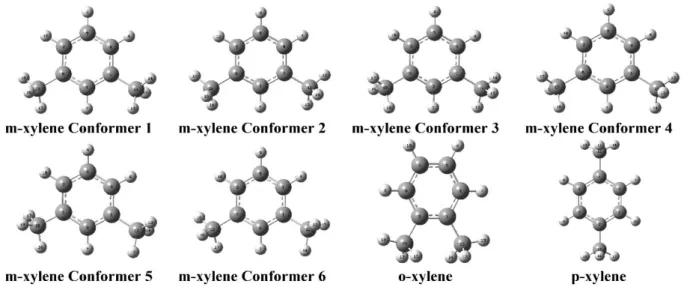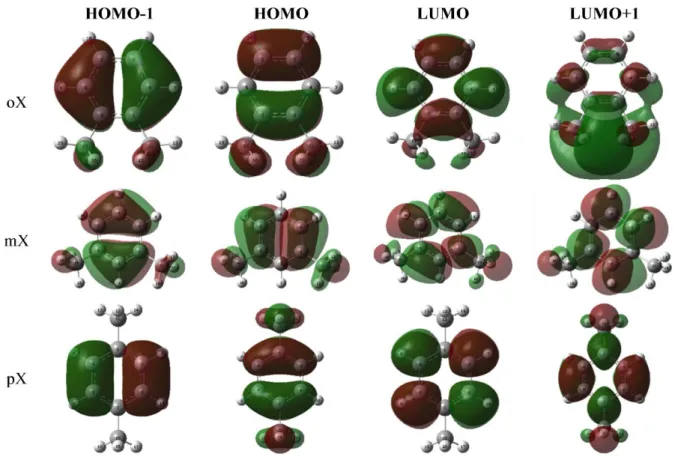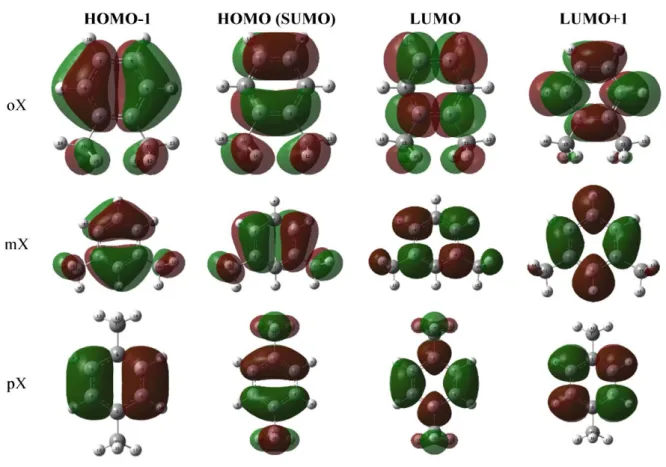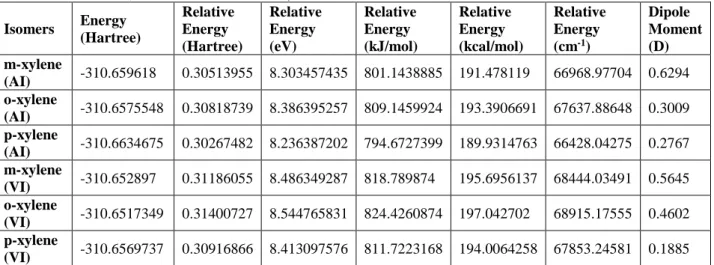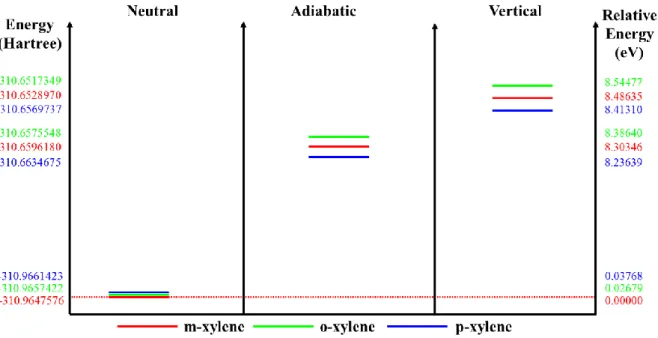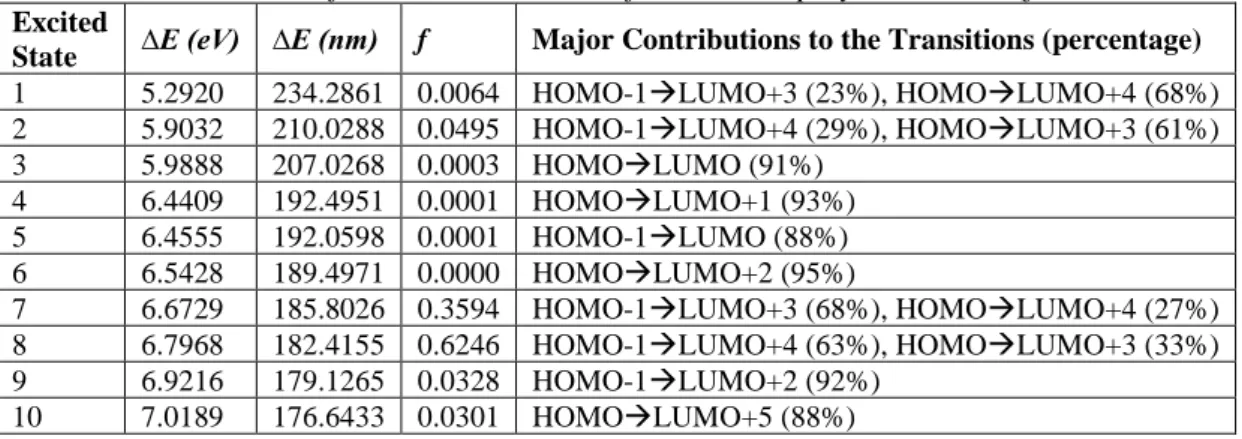*Corresponding author, e-mail:hamdisukurkilic@selcuk.edu.tr
http://dergipark.gov.tr/gujs
Molecular Structure and TD-DFT Study of the Xylene Isomers
Abdullah KEPCEOGLU1 ,Yasemin GUNDOGDU1 , Omer DERELI2 , Hamdi Sukur KILIC1,* 1Department of Physics, Faculty of Science, Selçuk University, Konya, Turkey
2Department of Physics, Faculty of A. Keleşoğlu Education, Necmettin Erbakan University, Konya, Turkey
Article Info Abstract
In this work, we have investigated the xylene isomers in concepts of vertical and adiabatic ionization energy parameters and molecular orbital (HOMO-1, HOMO/SOMO, LUMO, LUMO+1) energies of the neutrals and singly charged cation radicals. As a first step of the calculations, conformational analysis has been performed for all isomers using the semi-empirical method with PM3 core type Hamiltonian. Geometry optimization and frequency calculations were performed by using Density Functional Theory (DFT) with Becke, three-parameter, Lee-Yang-Parr (B3LYP) exchange-correlation functional and 6-311++G(d,p) basis sets. UV-Vis electronic spectra of the neutral xylene isomers were calculated by using the TD-DFT method with cam-B3LYP functional and 6-311++G(2d,2p) basis set.
Received: 25/01/2018 Accepted: 09/10/2018 Keywords TD-DFT Conformational Analysis UV-Vis Xylene 1. INTRODUCTION
Xylene molecule is known as an aromatic hydrocarbon with three isomers of ortho-, meta-, and para-xylene (also named as; 1,2-Dimethylbenzene, 1,3-Dimethylbenzene and 1,4-Dimethylbenzene respectively). As a volatile organic compound (VOC), xylenes are classified as the BTEX (Benzene, Toluene, Ethylbenzene and Xylenes) group chemicals. BTEX compounds toxicological effects and interaction with those compounds were regulated [1]. In literature, some calculations for STO-3G level molecular structure for o-xylene were performed [2].
In the recent works, various theoretical calculations about to understand the structure of singlet and triplet states, and some experimental works to investigate electronic excitation and time-resolved relaxation dynamics were carried out on the o-xylene [3]. Furthermore fs-photoelectron imaging-photo fragmentation spectroscopy was used by the same group to reveal ultrafast dynamics of the cationic state of the o-xylene [4]. In addition, ring opening or isomerization mechanisms were investigated by using ab-initio methods to understand photoisomerization and photodissociation dynamics of the m-xylene [5]. Similar calculations were performed for o-xylene [6,7]. Experimentally two methyl group rotational dynamics of the o-xylene were investigated and found that dependence of the methyl rotor barrier and the ionization potential was lower than the o- and m-xylene [8]. Similar calculations were performed for three xylene isomers by using ab-initio method and HF/6-31(d) level theory [9]. Experimental and theoretical (6-31G** level) works on
the vibronic properties of the ionic p-xylene molecule, and m-xylene [10], were given in literature [11]. In a recent work, intersystem crossing properties were investigated experimentally and theoretically [12] as well as due to vibrational and vibrational-torsional interactions [13,14].
In this work, we have investigated the neutrals and singly charged cation radicals of the xylene isomers in context of the vertical and adiabatic ionization energy parameters and molecular orbital (HOMO-1,
HOMO/SOMO, LUMO, LUMO+1) energies. In addition, UV-Vis spectra of the neutrals were also presented for three xylene isomers.
2. MATERIAL AND METHODS
In the present paper, firstly, we have determined the most stable molecular conformation, the conformational analysis of isomers of the xylene molecule was performed using semi-empirical method PM3 core type Hamiltonian using the Spartan08 (Wavefunction Inc., Irvine, CA) program [15]. Subsequently, geometry optimizations and frequency analysis of the all possible conformers have been performed by B3LYP functional with 6-311++G(d,p) basis set by using Gaussian09 program [16]. Meta-xylene has six different conformers but only one conformer found for each of ortho- and para-Meta-xylene. Since, the most stable conformer of the isomers determined, singly charged cation radicals have been modelled and these have been used for the calculations of the vertical and adiabatic ionization energy parameters and molecular orbitals (HOMO-1, HOMO, LUMO, LUMO+1). Adiabatic ionization parameters were calculated by optimizing radical molecular geometry and the same molecular geometry as the neutral were used to calculate the vertical ionization parameters. UV-VIS electronic spectra of the neutral xylene isomers were calculated by using the TD-DFT method with cam-B3LYP/6-311++G(2d,2p) functional and basis set, respectively.
3. RESULTS
The conformational analysis has been performed as described in computational details section to investigate some properties of the xylene isomers. The conformational analysis shows that o- and p-xylene have one conformer while m-xylene has six conformers as seen in Figure 1. Molecular energies and dipole moment values of the conformers are given in Table 1. The fifth conformer of the m-xylene has a minimum energy corresponding to 310.9647576 Hartree. These minima for o and pxylene are 310.9657422 and -310.9661423 Hartree or -0.02679 eV and -0.03768 eV relative to the fifth conformer of the m-xylene. Dipole moment values have appeared as meta<ortho<para and given to be 0.3402, 0.6755 and 0.7060 Debye. We have found that stable ortho- and para-xylene consisted with previous works except meta-xylene differs from previous work that one methyl group rotated in 180° [9].
Table 1. Energies and dipole moment values of the conformers of the Xylene isomers Isomers Energy (Hartree) Relative Energy (Hartree) Relative Energy (eV) Relative Energy (kJ/mol) Relative Energy (kcal/mol) Relative Energy (cm-1) Dipole Moment (D) m-xylene Conf5 -310.9647576 0.00000 0.00000 0.00000 0.00000 0.00000 0.3402 o-xylene -310.9657422 -0.00098 -0.02679 -2.58499 -0.61783 -216.08358 0.6755 p-xylene -310.9661423 -0.00138 -0.03768 -3.63569 -0.86895 -303.91328 0.7060 m-xylene Conf6 -310.9662373 -0.00148 -0.04027 -3.88490 -0.92851 -324.74537 0.3569 m-xylene Conf2 -310.9663249 -0.00157 -0.04265 -4.11510 -0.98353 -343.98850 0.3880 m-xylene Conf3 -310.9663268 -0.00157 -0.04270 -4.12007 -0.98472 -344.40330 0.3699 m-xylene Conf4 -310.9663269 -0.00157 -0.04271 -4.12033 -0.98478 -344.42524 0.3716 m-xylene Conf1 -310.9663270 -0.00157 -0.04271 -4.12054 -0.98483 -344.44280 0.3772
Table 2. HOMO-LUMO and Bandgap values of the neutral xylene isomers
Isomers ELUMO (a.u.) ELUMO (eV) EHOMO (a.u) EHOMO (eV) Egap (a.u) Egap (eV) m-xylene -0.23915 -6.5077498 -0.01346 -0.36627352 -0.22569 -6.14147628 o-xylene -0.24113 -6.56162956 -0.01061 -0.28871932 -0.23052 -6.27291024 p-xylene -0.23682 -6.44434584 -0.01462 -0.39783944 -0.22220 -6.04650640
HOMO-LUMO energies (a.u. and as eV unit) and the HOMO-LUMO energy gap values have given in Table 2 for the ground state neutral molecules. Energy gap values increase in the order ortho>meta>para. Neutral molecules HOMO-1, HOMO, LUMO and LUMO+1 orbitals presented in Figure 2. As shown in Figure 2, molecules exhibit π-type bonding. After geometry optimizations and frequency calculations, ionisation properties of the isomers have been investigated theoretically by means of the vertical and adiabatic process by removing one electron (charge: +1, multiplicity: 2). In order to calculate adiabatic ionization, an additional step (geometry optimization) have performed to simulate adiabatic relaxation to minimum molecular energy level. In contrast, for calculating vertically ionized molecules, its neutral geometries were used. HOMO-1, HOMO, LUMO and LUMO+1 orbitals of the adiabatically and vertically ionized molecules are presented in FigureS 3 and 4, respectively.
Figure 3. Molecular orbitals of the radicals (adiabatically ionised molecule)
Calculated molecular energies, relative energies to its neutrals and dipole moments are presented in Table 3 as well as energy diagrams of the xylene isomers are given in Figure 5. HOMO-LUMO energies (a.u. and as eV unit) and the HOMO-LUMO energy gap values have been given in Table 4 for the vertically and adiabatically ionized molecules.
Adiabatically ionized o, m and pxylene have minimum energies corresponding to 310.6575548, -310.659618 and -310.6634675 Hartree or 0.30818739, 0.30513955 and 0.30267482 Hartree relative to their neutrals. Vertically ionized oxylene, m and pxylene have minimum energies corresponding to -310.6517349 Hartree, -310.652897 and -310.656973 Hartree, respectively, and these are lower in the amount of 0.3140072, 0.31186055 and 0.30916866 Hartree than their neutrals, respectively.
In contrast to its neutral, dipole moment values appear as para<ortho<meta for both adiabatically and vertically ionized molecules.
Energy diagram of the isomers are presented in Figure 5 shows that the neutral molecular energies for isomers increase in order of meta<ortho<para when they lose one of their electrons (i.e. after ionization), this trend changes to the order of para<meta<ortho for both electron loss mechanism (Vertical or Adiabatic). As expected, adiabatic energy levels are lying lower than the vertical molecular energy levels.
Table 3. Molecular energies (relative to its neutrals) and dipole moments of the xylene isomers (AI:
Adiabatic Ionization, VI: Vertical Ionization) Isomers Energy (Hartree) Relative Energy (Hartree) Relative Energy (eV) Relative Energy (kJ/mol) Relative Energy (kcal/mol) Relative Energy (cm-1) Dipole Moment (D) m-xylene (AI) -310.659618 0.30513955 8.303457435 801.1438885 191.478119 66968.97704 0.6294 o-xylene (AI) -310.6575548 0.30818739 8.386395257 809.1459924 193.3906691 67637.88648 0.3009 p-xylene (AI) -310.6634675 0.30267482 8.236387202 794.6727399 189.9314763 66428.04275 0.2767 m-xylene (VI) -310.652897 0.31186055 8.486349287 818.789874 195.6956137 68444.03491 0.5645 o-xylene (VI) -310.6517349 0.31400727 8.544765831 824.4260874 197.042702 68915.17555 0.4602 p-xylene (VI) -310.6569737 0.30916866 8.413097576 811.7223168 194.0064258 67853.24581 0.1885
Table 4. HOMO-LUMO energies and Bandgap values of the xylene isomers
Isomers ELUMO (a.u.) ELUMO (eV) EHOMO (a.u) EHOMO (eV) Egap (a.u) Egap (eV) m-xylene -0.24063 -6.54802356 -0.45905 -12.4916686 0.21842 5.94364504 o-xylene -0.23931 -6.51210372 -0.45947 -12.50309764 0.22016 5.99099392 p-xylene -0.23355 -6.3553626 -0.46423 -12.63262676 0.23068 6.27726416 m-xylene -0.23024 -6.26529088 -0.46921 -12.76814252 0.23897 6.50285164 o-xylene -0.23137 -6.29604044 -0.47062 -12.80651144 0.23925 6.510471 p-xylene -0.22586 -6.14610232 -0.46133 -12.55371196 0.23547 6.40760964
Figure 5. Energy diagram of the xylene isomers (energies relative to the neutral molecular energy)
Figure 6. Calculated UV-Vis spectra of the xylene isomers (GaussSum [17] program was used to plot
spectra)
UV-Vis spectra of the xylene isomers are presented in Figure 6. All isomers have a strong absorption band around 180 nm and relatively small absorption band around 210 nm are observed due to calculation results. Major contributions to the UV-Vis spectra and corresponding transitions are presented in Table 5 to 7.
For the o-xylene isomer, leading contributions to UV-Vis spectrum originated from HOMO-1→LUMO+4 (54%), HOMO→LUMO+3 (43%) transitions with 6.8826 eV energy gap, HOMO-1→LUMO+2 (87%) transition with 6.8257 eV energy gap and HOMO-1→LUMO+3 (58%), HOMO→LUMO+4 (37%) transitions with 6.7939 eV energy gap values.
In the matter of m-xylene isomer, leading contributions to UV-Vis spectrum originated from 1→LUMO+4 (58%) and HOMO→LUMO+3 (33%) transitions with 6.7899eV energy gap, HOMO-1→LUMO+3 (38%), HOMO→LUMO+2 (18%) and HOMO→LUMO+4 (32%) transitions with 6.6496eV energy gap and HOMO-1→LUMO+3 (12%), HOMO→LUMO+2 (61%) transitions with 6.6282eV energy gap values.
In case of the p-xylene isomer, leading contributions to UV-Vis spectrum originated from HOMO-1→LUMO+4 (63%), HOMO→LUMO+3 (33%) transitions with corresponding to 6.7968 eV energy gap, HOMO-1→LUMO+3 (68%), HOMO→LUMO+4 (27%) transitions with 6.6729 eV energy gap values.
Table 5. TD-DFT results for the excited states of the neutral o-xylene isomer (f is the oscillator strength)
Excited State
∆E
(eV) ∆E (nm) f Major Contributions to the Transitions (percentage)
1 5.3952 229.8046 0.0024 HOMO-1→LUMO+4 (41%), HOMO→LUMO+3 (50%) 2 6.0168 206.0633 0.0107 HOMO-1→LUMO+3 (36%), HOMO→LUMO+4 (59%) 3 6.0871 203.6835 0.0089 HOMO→LUMO (88%) 4 6.3381 195.6173 0.0000 HOMO-1→LUMO (79%), HOMO-1→LUMO+1 (11%) 5 6.4711 191.5968 0.0024 HOMO→LUMO+1 (90%) 6 6.6796 185.6162 0.0000 HOMO-1→LUMO+1 (11%), HOMO→LUMO+2 (83%) 7 6.7939 182.4934 0.4973 HOMO-1→LUMO+3 (58%), HOMO→LUMO+4 (37%) 8 6.8257 181.6432 0.0218 HOMO-1→LUMO+2 (87%)
9 6.8375 181.3297 0.0000 1->LUMO (11%), 1→LUMO+1 (72%), HOMO->LUMO+2 (10%)
10 6.8826 180.1415 0.7328 HOMO-1→LUMO+4 (54%), HOMO→LUMO+3 (43%)
Table 6. TD-DFT results for the excited states of the neutral m-xylene isomer (f is the oscillator strength)
Excited State
∆E
(eV) ∆E (nm) f Major Contributions to the Transitions (percentage)
1 5.3387 232.2367 0.0033 HOMO-1→LUMO+3 (11%), HOMO-1→LUMO+4 (25%), HOMO→LUMO+3 (41%), HOMO→LUMO+4 (11%) 2 5.9371 208.8296 0.0112 HOMO-1→LUMO+3 (32%), HOMO→LUMO+3 (17%), HOMO→LUMO+4 (37%) 3 6.0983 203.3094 0.0000 HOMO→LUMO (88%) 4 6.3239 196.0565 0.0031 HOMO-1→LUMO (88%) 5 6.5916 188.0942 0.0061 HOMO→LUMO+1 (74%) 6 6.6282 187.0556 0.1001 HOMO-1→LUMO+3 (12%), HOMO→LUMO+2 (61%) 7 6.6496 186.4536 0.3292 HOMO-1→LUMO+3 (38%), HOMO→LUMO+2 (18%), HOMO→LUMO+4 (32%) 8 6.7899 182.6009 0.6726 HOMO-1→LUMO+4 (58%), HOMO→LUMO+3 (33%) 9 6.7984 182.3726 0.0210 HOMO-1→LUMO+2 (82%) 10 6.9633 178.0538 0.0001 HOMO-1→LUMO+1 (89%)
Table 7. TD-DFT results for the excited states of the neutral p-xylene isomer (f is the oscillator strength)
Excited
State ∆E (eV) ∆E (nm) f Major Contributions to the Transitions (percentage) 1 5.2920 234.2861 0.0064 HOMO-1→LUMO+3 (23%), HOMO→LUMO+4 (68%) 2 5.9032 210.0288 0.0495 HOMO-1→LUMO+4 (29%), HOMO→LUMO+3 (61%) 3 5.9888 207.0268 0.0003 HOMO→LUMO (91%) 4 6.4409 192.4951 0.0001 HOMO→LUMO+1 (93%) 5 6.4555 192.0598 0.0001 HOMO-1→LUMO (88%) 6 6.5428 189.4971 0.0000 HOMO→LUMO+2 (95%) 7 6.6729 185.8026 0.3594 HOMO-1→LUMO+3 (68%), HOMO→LUMO+4 (27%) 8 6.7968 182.4155 0.6246 HOMO-1→LUMO+4 (63%), HOMO→LUMO+3 (33%) 9 6.9216 179.1265 0.0328 HOMO-1→LUMO+2 (92%) 10 7.0189 176.6433 0.0301 HOMO→LUMO+5 (88%)
4. CONCLUSION
In this study, TD-DFT calculations for xylene isomers are discussed in details to reveal effect of the relative positions of the methyl groups. Conformational analysis indicates that molecular geometries of the stable ortho- and para-xylene consisted with literature except for meta-xylene, which differs from literature that one methyl group rotated in 180°. Since the conformational analysis has been applied for xylene isomers, the vertical and adiabatic ionization energy parameters and molecular orbital (HOMO-1, HOMO/SOMO, LUMO, LUMO+1) energies of the neutrals and singly charged cation radicals have been calculated, respectively. The neutral molecular energies and the bandgap values of the conformers increase in the order ortho>meta>para and theoretical calculations shown that this trend changes to the order of para<meta<ortho for both electron loss mechanism (Vertical or Adiabatic). First ten excited states energies and oscillator strengths as well as corresponding UV-Vis spectra have been presented for three xylene isomers.
ACKNOWLEDGMENTS
Authors kindly would like to thank, Scientific Research Projects Coordinator office of Selçuk University for financial support via Project Number: 14201085 and Scientific and Technical Research Council of Turkey (TUBITAK) for financial support via Grant No: 1649B031405880.
CONFLICTS OF INTEREST
No conflict of interest was declared by the authors.
REFERENCES
[1] Wilbur, S., Bosch, S., "Interaction profile for: benzene, toluene, ethylbenzene, and xylenes (BTEX)", Agency for Toxic Substances and Disease Registry, U.S. Department of Health and Human Services, Public Health Service, Atlanta, GA., (2004).
[2] Henry, B.R., Wildman, T.A., "Conformational preferences and internal rotation in toluene, o-xylene and hexamethylbenzene", Journal of Molecular Structure: THEOCHEM, 124, 71-85, (1985).
[3] Liu, Y., Knopp, G., Hemberger, P., Sych, Y., Radi, P., Bodi, A., Gerber, T., "Ultrafast imaging of electronic relaxation in o-xylene: a new competing intersystem crossing channel", Physical Chemistry Chemical Physics, 15, 18101-18107, (2013).
[4] Liu, Y., Radi, P., Gerber, T., Knopp, G., "Study on the ultrafast dynamics of o-xylene cation by combined fs-photoelectron imaging-photofragmentation spectroscopy", Chemical Physics, 442, 48-52, (2014).
[5] Huang, C.L., Jiang, J.C., Lee, Y.T., Ni, C.K., "Photoisomerization and Photodissociation of m-Xylene in a Molecular Beam", The Journal of Physical Chemistry A, 107, 4019-4024, (2003).
[6] Disselkamp, R., Bernstein, E., Seeman, J.I., Secor, H.V., "Minimum energy conformation of ortho‐ xylene in its ground and first excited electronic states", The Journal of chemical physics, 97, 8130-8136, (1992).
[7] Droz, T., Leutwyler, S., Mandziuk, M., Bačić, Z., "Intermolecular vibrations of o‐xylene⋅ Ar in the S 0 and S 1 states: Experiment and quantum three dimensional calculations", The Journal of chemical physics, 101, 6412-6423, (1994).
[8] Held, A., Selzle, H.L., Schlag, E.W., "Methyl group rotational dynamics in o-, m-, and p-xylene cations from pulsed field ionization zero-kinetic-energy spectroscopy", The Journal of Physical Chemistry A, 102, 9625-9630, (1998).
[9] Rong, Z., Kjaergaard, H.G., "Internal Methyl Rotation in the CH Stretching Overtone Spectra of ortho-, meta-ortho-, and para-Xylene"ortho-, The Journal of Physical Chemistry Aortho-, 106ortho-, 6242-6253ortho-, (2002).
[10] Zhang, S., Tang, B., Wang, Y., Zhang, B., "Vibrational spectrum and ab initio calculations of m-xylene", Chemical physics letters, 397, 495-499, (2004).
[11] Zhang, B., Aigner, U., Selzle, H.L., Schlag, E.W., "Vibrational levels of p-xylene cation determined by mass-analyzed threshold ionization spectroscopy", Chemical physics letters, 380, 337-341, (2003).
[12] Stephansen, A.B., Solling, T.I., "Distortion dependent intersystem crossing: A femtosecond time-resolved photoelectron spectroscopy study of benzene, toluene, and p-xylene", Structural Dynamics, 4, 044008, (2017).
[13] Tuttle, W.D., Gardner, A.M., O’Regan, K.B., Malewicz, W., Wright, T.G., "Vibrational and vibrational-torsional interactions in the 0–600 cm− 1 region of the S1← S0 spectrum of p-xylene investigated with resonance-enhanced multiphoton ionization (REMPI) and zero-kinetic-energy (ZEKE) spectroscopy", The Journal of chemical physics, 146, 124309, (2017).
[14] Gardner, A.M., Tuttle, W.D., Groner, P., Wright, T.G., "Molecular symmetry group analysis of the low-wavenumber torsions and vibration-torsions in the S1 state and ground state cation of p-xylene: An investigation using resonance-enhanced multiphoton ionization (REMPI) and zero-kinetic-energy (ZEKE) spectroscopy", The Journal of chemical physics, 146, 124308, (2017).
[15] Shao, Y., Molnar, L., Jung, Y., Kussmann, J., Ochsenfeld, C., Brown, S., Gilbert, A., Slipchenko, L., Levchenko, S., O’Neill, D., "Advances in methods and algorithms in a modern quantum chemistry program package", Physical Chemistry Chemical Physics, 8, 3172-3191, (2006).
[16] Frisch, M.J., Trucks, G.W., Schlegel, H.B., Scuseria, G.E., Robb, M.A., Cheeseman, J.R., Scalmani, G., Barone, V., Mennucci, B., Petersson, G.A., "Gaussian 09, revision a. 02", Gaussian, Inc., Wallingford, CT., (2009).
[17] O'Boyle, N.M., Tenderholt, A.L., Langner, K.M., "cclib: a library for package-independent computational chemistry algorithms", Journal of computational chemistry, 29, 839-845, (2008).
